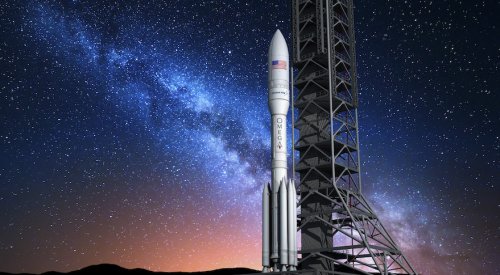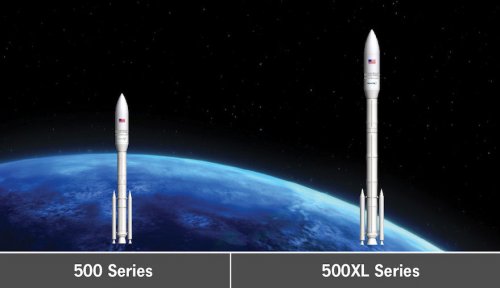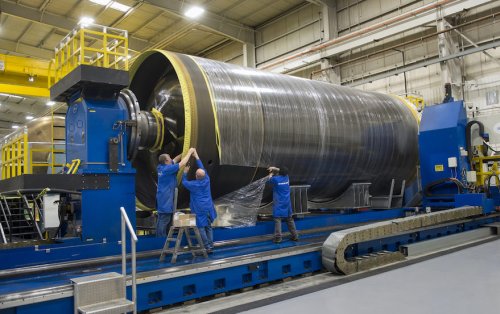COLORADO SPRINGS — Orbital ATK on Monday revealed new details about the rocket it has been developing over the last three years in an effort to take U.S. Air Force launch contracts away from United Launch Alliance and SpaceX.
With the Air Force expected to select up to three companies this summer to build and test rockets capable of launching intermediate to heavy-class national security payloads, Orbital ATK executives announced at the 34th Space Symposium here that they have picked Aerojet Rocketdyne’s RL10C engine to power the upper stage of a next-generation launch vehicle they are now calling OmegA.
OmegA’s solid-fuel lower stages, as previously disclosed, are based on space shuttle solid rocket motor segments developed by Orbital ATK, and solid strap-on boosters used on ULA’s rockets.
OmegA was developed under a three-year, $250 million cost-sharing partnership with the Air Force. At a news conference, Orbital ATK spokesman Barron Beneski said OmegA is the “number one priority for growth initiatives in the company, and is projected to be the largest discretionary spending item in the company over the next couple of years.”
The new rocket will compete against SpaceX, ULA and Blue Origin for further development contracts the Air Force plans to award under its Launch Services Agreement (LSA) program this summer. Before naming the rocket OmegA, the company had been using the name “next generation launch system” as a placeholder, said Scott Lehr, president of Orbital ATK’s Flight Systems Group.
OmegA is on a path to complete propulsion system ground tests in 2019 and conduct its first launch in 2021.
Orbital ATK chose the existing RL10C for the upper stage rather than gamble on a new development. “It has an extensive flight history and provides a low-risk affordable engine,” said Mike Pinkston, deputy general manager of Orbital ATK’s launch vehicles division.
The RL10C is currently used by ULA to power the Centaur upper stage used on its Atlas 5 and Delta 4 rockets.
As recently as a year ago, Orbital ATK planned to use a vacuum-optimized of Blue Origin’s BE-3 engine that the Jeff Bezos-owned company is currently flying on its New Shepard suborbital vehicle.
Both the BE-3U and a variant of Aerojet Rocketdyne’s RL10 are in the running for Vulcan, the next-gen rocket ULA is using to go after the same pot of Air Force LSA money as Blue Origin, Orbital ATK and SpaceX. Orbital ATK provides solid rocket motors for Vulcan. Lehr said the manufacturing of solid rocket motors for Vulcan will be “firewalled” from the OmegA program.
The next phase of the OmegA program will begin after the Air Force makes the next round of LSA awards in July. That would allow for further development and verification of the vehicle and its launch sites.
Orbital ATK officials said that after initial flights of its intermediate configuration in 2021, OmegA will be Air Force certified for operational missions starting in 2022, with initial heavy configuration flights beginning in 2024.
About 500 employees currently are working on OmegA, the company said, and the number is expected to grow to 1,000 over the next 18 months.
Pinkston said Orbital ATK expects OmegA to be cost-competitive in both the EELV and commercial markets, but said he could not provide any price estimates yet. The company is in search of customers. “We have some ‘letters of intent’ in hand for payloads,” he said. With Orbital ATK being a major satellite manufacturer, the plan is to offer “our own sallites in our own rockets for an attractive price.”
- Why Sierra Nevada’s owners are betting big on Dream Chaser
- SN Military.Space | DoD elated by budget hike, but good times may not last • USAF ready to ‘go fast’ in space • Three-star space commander swearing in
- #SpaceForce takes Capitol Hill by storm • What is the true cost of space programs? • Space budget deep dive
- SpaceX takes top honors in SpaceNews Awards for Excellence & Innovation
- Space Corps proposal becoming flashpoint in DoD budget negotiations
Share with your friends




(0) Comments
This article comments are currently no :(